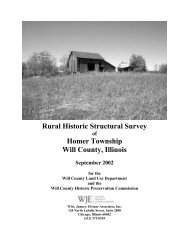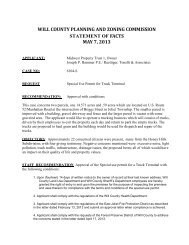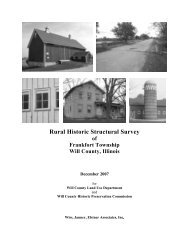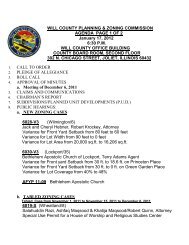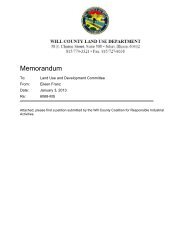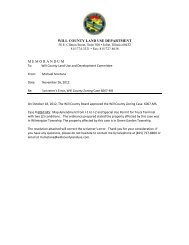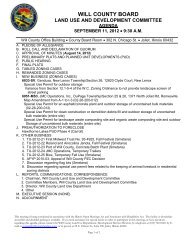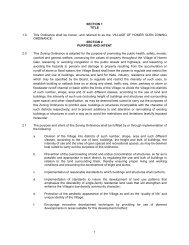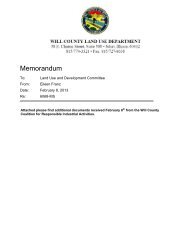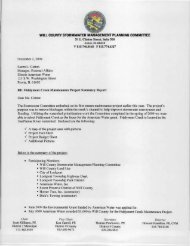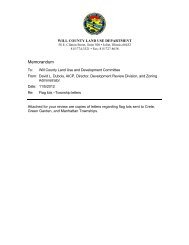Rural H Historic c Struct tural S Survey - Will County Land Use
Rural H Historic c Struct tural S Survey - Will County Land Use
Rural H Historic c Struct tural S Survey - Will County Land Use
You also want an ePaper? Increase the reach of your titles
YUMPU automatically turns print PDFs into web optimized ePapers that Google loves.
Wiss, Janney, Elstner Associates, Inc.<br />
The coming of the Great Depression deepened the crisis further. Agricul<strong>tural</strong> production in Illinois<br />
collapsed from almost $6.25 billion in 1929 to $2.5 billion in 1933. As unemployment in industrial<br />
centers soared, some people fled to rural communities, putting additional pressure on rural areas as most<br />
did not have access to welfare relief. 51 Within days of the inauguration of Franklin Roosevelt, legislation<br />
was formulated that Congress would later pass as the Agricul<strong>tural</strong> Adjustment Act. The numerous<br />
adjustment programs initiated under the New Deal led to limitations in agricul<strong>tural</strong> production in order to<br />
raise crop prices to acceptable levels. These included twenty percent of the land or 1,218,062 acres used<br />
in corn production being retired; over 1,000,000 acres of land in wheat production were also retired. 52 In<br />
1934, 15,734,600 acres of land were in production, for a total crop value of $218,569,000 nationally; this<br />
grew to 17,692,100 acres and a crop value of $273,931,000 the following year. 53<br />
Soybeans were first planted in the late 1930s as a forage crop mainly to be fed to dairy cows and cattle.<br />
Although some soybeans were processed through a threshing machine and sold on the market it was not a<br />
popular grain product. Ten or fifteen years later, however, soybeans became a valuable food and<br />
commercial product as new uses were developed with the assistance of state and federal agricul<strong>tural</strong><br />
programs.<br />
During World War II, farmers were encouraged by the federal government to increase their production by<br />
the use of power machinery and the latest scientific processes. When a decline in demand arose, the<br />
farmer was forced to continue his heavy production rate. Cash crop income in 1950 was $2.038 billion<br />
nationally. Of this livestock and livestock products accounted for $1.26 billion; crops, $763 million; and<br />
government pay for adaptation of production program, with $10.6 million paid to the farmers in Illinois.<br />
Principal crops were corn, soybeans, wheat, oats, hay, fruit, and greenhouse products. The average value<br />
of a farm in Illinois in 1950 was $28,400. 54 The farm population in Illinois declined from 1,341,104 in<br />
1900 to 772,521 in 1950. 55<br />
The abandoning of farms and the consolidation of small farms into large ones resulted in many buildings<br />
being razed or abandoned. Moreover, changes in farming meant that many old farm buildings were too<br />
small, or unsuitable for other reasons, and were replaced by larger, more suitable and flexible structures.<br />
By the twentieth century many barns were constructed by professional builders following plans<br />
influenced by farm journals and using mass-produced lumber from a nearby yard or sawmill. In 1987,<br />
there were 1,239 farms in <strong>Will</strong> <strong>County</strong> covering 328,729 acres. Ten years later, the continued decline in<br />
agricul<strong>tural</strong> production in northeastern Illinois was apparent, as farmland was lost to suburban<br />
development. By 1997, there were only 910 farms in <strong>Will</strong> <strong>County</strong>, and though the average farm was<br />
larger, the total acreage devoted to agriculture had declined by more than 10 percent to 293,526 acres.<br />
After dipping to only 830 farms in the county in 2002, the number of farms in the county increased<br />
slightly by 2007 to 877. The total acreage in the county continued to decline steadily, however, and by<br />
2007 only 220,851 acres remained in agricul<strong>tural</strong> use, representing less than half the total area of the<br />
county and a loss of more than 100,000 acres in the twenty years since 1987. In recent years almost half<br />
the farm acreage in the county remained planted in corn, with soybeans covering another quarter of the<br />
acreage. Raising beef cattle, dairy, and hogs also remained significant cash products in the county. The<br />
average farm sold crops worth more than $145,000 in 2007. Between 2002 and 2007, the value of<br />
products sold directly to individual consumers by <strong>Will</strong> <strong>County</strong> farms more than doubled to $1.3 million,<br />
reflecting the increasing popularity of farmer’s markets and vegetable crops in the county. 56<br />
51<br />
Morrison, Prairie State, A History, 108.<br />
52<br />
United States Department of Agriculture, Yearbook of Agriculture (1936), 1155–1156.<br />
53<br />
Ibid., 1146.<br />
54<br />
Morrison, Prairie State, A History, 116.<br />
55 Salamon, 35.<br />
56 Ibid.; Census of Agriculture.<br />
<strong>Will</strong> <strong>County</strong> <strong>Rural</strong> <strong>Historic</strong> <strong>Struct</strong>ural <strong>Survey</strong><br />
Page 20 Florence Township



